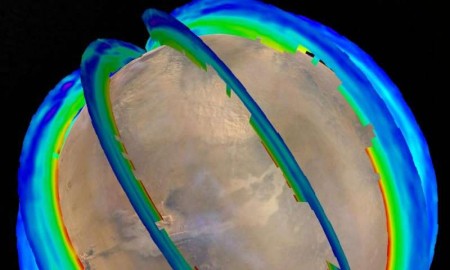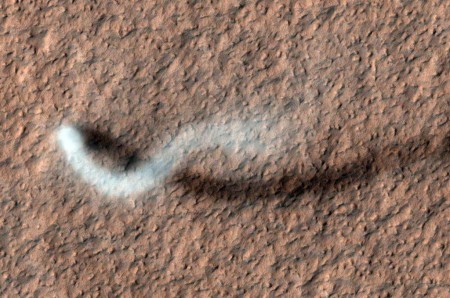June 13, 2016 – Mars has winter, summer and dust storm season. In a paper entitled, Interannual similarity in the Martian atmosphere during the dust storm season, appearing in this month’s Geophysical Research Letters, the authors report the existence of a dusty season on Mars. In the movie, The Martian, a dust storm separates Mark Watney from his fellow astronauts and leaves him marooned on the planet. The depiction of the dust storm in the movie shows an intensity that you might not think possible in an atmosphere as tenuous as that on Mars. And in fact it is not. So what makes for a good movie is not good science.
According to NASA, based on more than two decades of atmospheric data gathering, the low atmospheric pressure on Mars makes dust storms unlikely to meet the ferocity seen in the movie. At their most intense storms produce wind speeds reaching 100 kilometers (approximately 60 miles) per hour. But in the low atmospheric pressure (1% of Earth’s) that’s not enough wind to get a kite to fly let alone to break a telecommunications mast and send it flying into an astronaut impaling him.
Mars does get dust storms that we can see from Earth-based telescopes. Some are as expansive as a continent-wide cyclonic storm should one happen here on Earth. Of course storms that size only happen in movies like The Day After Tomorrow, another good movie that is not good science.
The reality is about once every 3 Martian years (5.5 Earth years) Mars gets significant dust storms. The largest storms on Mars are more common to the planet’s southern hemisphere when it is summer and the planet’s orbit is at perihelion (closest to the Sun). In the past some have gone rogue and encircled the entire planet. When Mariner 9 reached Mars in November of 1971, the entire planet’s surface was completely obscured. The last big one occurred in 2007. Scientists believe Mars is overdue for the next one.
But that’s not the biggest concern for any human crew that arrives on Mars. The Watney experience is highly unlikely. When the movie depicts Watney outside the habitat or his rover, his suit should be covered in Martian dust based on what scientists have observed from rovers and landers on the planet’s surface. Dust on Mars is electromagnetic and clings to equipment. It settles everywhere interfering with photovoltaic panels cutting the amount of energy they yield. Dust devils captured by Spirit’s, Curiosity’s and Opportunity’s cameras can cover equipment in a layer of the stuff or do the exact opposite and clean the surfaces to an almost pristine condition. Dust devils as captured in this image taken by the Mars Reconaissance Orbiter courtesy of Jet Propulsion Laboratory-Caltech and University of Arizona, shouldn’t be confused with dust storms. The former appear to be common daily occurrences produced by local surface heating. They are short duration.
Another fact about Martian storms is they are unlike any that occur here on Earth. As soon as a storm gets going it produces the seeds of its own destruction. The mechanism driving it is sunlight reaching the Martian surface producing radiative heat. When it arises it effectively begins to block the heat source diminishing it within a short period. During a storm dusty Martian air can be as much as 35 Celsius (63 Fahrenheit) degrees warmer than clear air within the vicinity.
The data used to produce the paper has been accumulated from Mars orbiters in continuous operation around the planet since 1997. The image below graphically presents what happens to the Martian atmosphere during a regional dust storm. Temperature is colour coded with the warmest appearing in red near the surface and the coldest in the deep blue at about 80 kilometers (50 miles) up. Temperatures depicted here range from minus 23 Celsius (minus 9 Fahrenheit) at the surface to minus 153 Celsius (minus 243 Fahrenheit) at 80 kilometers. The image was produced by NASA and the Jet Propulsion Laboratory-Caltech.

















